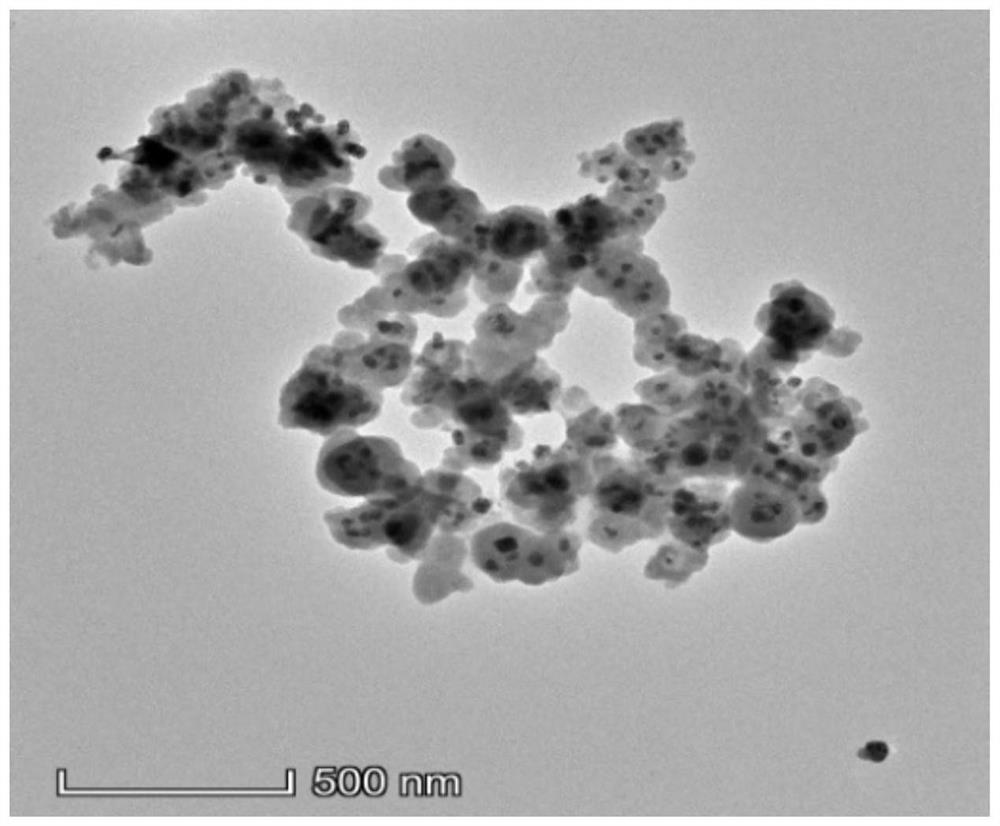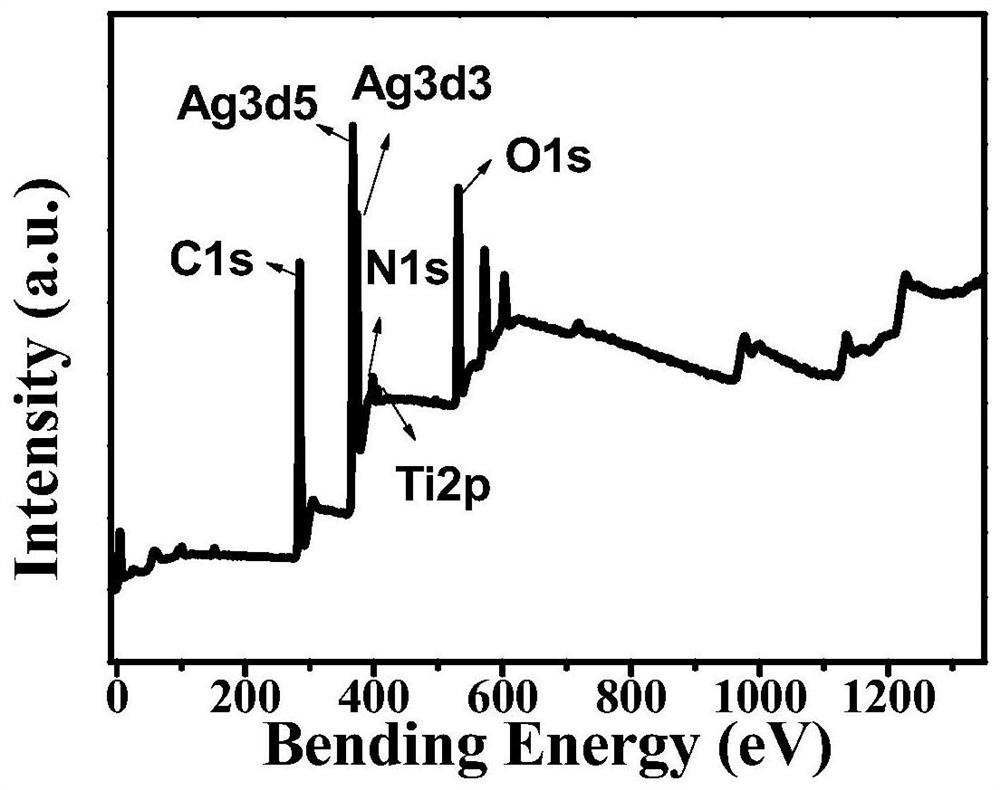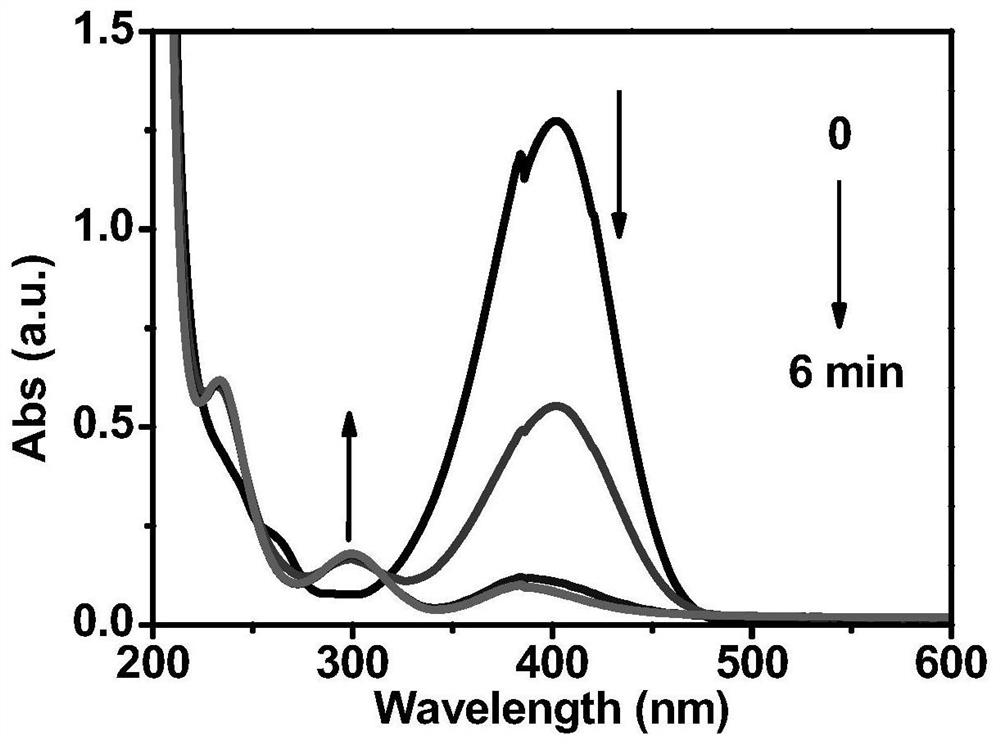MXene-based two-dimensional silver compound as well as preparation method and application thereof
A composite, silver salt technology, applied in the field of carbon nanomaterials, can solve the problems of using toxic reagents, a large number of catalysts and raw materials, low catalytic efficiency, etc., and achieve the effects of reducing agglomeration, simple reaction process, and improving reaction rate.
- Summary
- Abstract
- Description
- Claims
- Application Information
AI Technical Summary
Problems solved by technology
Method used
Image
Examples
Embodiment 1
[0035] The MXene-based two-dimensional silver composite provided in this example is prepared through the following steps:
[0036] 1) Add 0.5gTi 3 AlC 2 Dissolve in 10mL 48% HF, stir at 60°C for 20h, centrifuge the reacted solution at 3000rpm for 10min, and dry the solid to obtain MXene;
[0037] 2) The cuttlefish juice powder and water were subjected to a carbonization reaction at 180°C for 12 hours at a ratio of 1:20, and then freeze-dried for 24 hours to obtain a water-soluble fluorescent carbon quantum dot solid;
[0038] 3) Dissolve 0.05 g of the water-soluble fluorescent carbon quantum dot solid with distilled water, and make it into a 0.5 mg / mL water-soluble fluorescent carbon quantum dot solution at a constant volume in a 100 mL volumetric flask, ready for use.
[0039] 4) Take 100mL of the water-soluble fluorescent carbon quantum dot solution prepared above and place it in a 250mL round-bottom flask. The outer wall of the round-bottom flask is covered with tin foil ...
Embodiment 2
[0043] The MXene-based two-dimensional silver composite provided in this example is prepared through the following steps:
[0044] 1) Add 0.5gTi 3 AlC 2 Dissolve in 10mL 48% HF, stir at 60°C for 20h, centrifuge the reacted solution at 3000rpm for 10min, and dry the solid to obtain MXene;
[0045] 2) The cuttlefish juice powder and water were subjected to a carbonization reaction at 180°C for 12 hours at a ratio of 1:20, and then freeze-dried for 24 hours to obtain a water-soluble fluorescent carbon quantum dot solid;
[0046]3) Dissolve 0.05 g of the water-soluble fluorescent carbon quantum dot solid with distilled water, and make it into a 0.5 mg / mL water-soluble fluorescent carbon quantum dot solution at a constant volume in a 100 mL volumetric flask, ready for use.
[0047] 4) Take 100mL of the water-soluble fluorescent carbon quantum dot solution prepared above and place it in a 250mL round-bottomed flask. The outer wall of the round-bottomed flask is covered with tin fo...
Embodiment 3
[0049] The MXene-based two-dimensional silver composite provided in this example is prepared through the following steps:
[0050] 1) Add 0.5gTi 3 AlC 2 Dissolve in 10mL 48% HF, stir at 60°C for 20h, centrifuge the reacted solution at 3000rpm for 10min, and dry the solid to obtain MXene;
[0051] 2) The cuttlefish juice powder and water were subjected to a carbonization reaction at 180°C for 12 hours at a ratio of 1:20, and then freeze-dried for 24 hours to obtain a water-soluble fluorescent carbon quantum dot solid;
[0052] 3) Dissolve 0.05 g of the water-soluble fluorescent carbon quantum dot solid with distilled water, and make it into a 0.5 mg / mL water-soluble fluorescent carbon quantum dot solution at a constant volume in a 100 mL volumetric flask, ready for use.
[0053] 4) Take 100mL of the water-soluble fluorescent carbon quantum dot solution prepared above and place it in a 250mL round-bottomed flask. The outer wall of the round-bottomed flask is covered with tin f...
PUM
| Property | Measurement | Unit |
|---|---|---|
| particle diameter | aaaaa | aaaaa |
Abstract
Description
Claims
Application Information
 Login to View More
Login to View More - R&D
- Intellectual Property
- Life Sciences
- Materials
- Tech Scout
- Unparalleled Data Quality
- Higher Quality Content
- 60% Fewer Hallucinations
Browse by: Latest US Patents, China's latest patents, Technical Efficacy Thesaurus, Application Domain, Technology Topic, Popular Technical Reports.
© 2025 PatSnap. All rights reserved.Legal|Privacy policy|Modern Slavery Act Transparency Statement|Sitemap|About US| Contact US: help@patsnap.com



